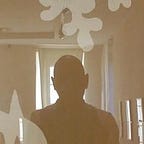Iterative Drawing — a (somewhat) serious game
This time, a game I developed that demonstrates the power of team work.
Preface
I must confess I don’t like most exercise (AKA games) to demonstrate team-work, since they seem competitive and focus on performance, you measure quality, quantity, waste, etc. by some objective KPI.
As a drawing-facilitator (in lack of a better definition) I once ran this in a Parisian coffee house to my fellow pencil-carrying mates.
The idea is to see what happens when you share responsibility as a team, how does creativity flows. There are no Pass/ Fail criteria or KPIs.
Materials & duration
Duration: 10 minute activity and 20–30 minute showcase and retrospective.
You’ll need:
- Two sheets of paper per participant (I used A5, to give intimacy)
- Pens/ pencils (preferably different colors, widths, etc)
- Round/ square tables (and chairs) to sit around in groups of four to seven (one people can go around to change places)
- One model (statue/ toy) to draw per table (can be a McDonald’s prize, as you can see below)
- A timer
Preparation:
- Put the model at the center of the table.
- Team (6 people is a perfect size) sits around the model, ready to draw what they see. (you can have a few teams in parallel, in this example I ran three)
Instructions
Iteration number one:
- You have three minutes to:
- Draw the model (just as you see it)
- Write at the bottom a meaningful six-word sentence (anything) - I will warn you 20 seconds ahead of time, and you should stop when time is up.
Iteration number two:
- You have three minutes to (just as before)
- Draw the model (just as you see it)
- Write at the bottom a meaningful six-word sentence (anything)
however:
- You will work in six 30-second sprints. (total of three minutes, as before)
- In each sprint you will draw what you see, and write one word on the page.
- When a sprint is over (30 seconds), the next starts immediately,
you will:
- Shift places:
Get up, leave the paper in place (for your successor), but take your pen with you.
Move to the sit on your left (around the table)
- Continue the drawing on your new position, and add one word to the sentence that is there.
Note: there is no break between the short iterations! (so no one can say the drawings are better but it took longer if we include meetings…)
Some points/ ideas for discussion
Run in each table a mini exposition, where each member presents the two drawings, and the table discusses their experience.
- Which of the two drawings looks richer?
- Which of the two sentences is more interesting?
- Who is the owner of each drawing?
- In the first iteration,
- were there any incomplete drawings?
- People who finished ahead of time? (what did they do in this time?)
- How did people who ‘can’t draw’ feel?
In the second iteration: same question… - Did the people who ‘can’t draw’ learn anything about drawing?, did the people who ‘do know’ learn anything?
Some additional points (from my experience)
- Second iteration looks more wasteful ‘on paper’ but it isn’t (drawing are richer and more detailed/ complete)
- People get to see the whole picture (not just the back or the front of the model)
- There is uniformity in the results (for good or bad)
- Different people bring complementary skills, some go into details, some draw big features, some fill areas, some lines, all this makes the result very rich.
- How do you feel about ownership? do you feel the second drawing is yours? or you were ‘just’ doing something on it? were you afraid to ruin someone’s work? that someone ‘ruins’ yours?
- If there is someone who insists to ‘just add a line or two’ at the end of the sprint, it blocks all the rest from sitting down and starting the new sprint, and they have less time to ‘work’.
- If someone started drawing small, the rest will continue a small drawing, if big, they will continue a big one.
- Sample text in first iteration: “I’m not sure what I’m doing”, second: “I’m drawing someone photo old raccoon”
- etc, etc…
Feedback?
Let me know if you try it!
What were your variations and insights?
